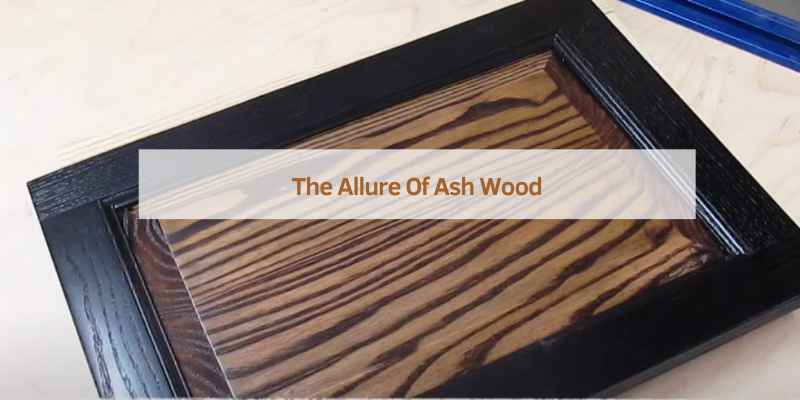Ash wood finish can vary with oil-based, water-based, or gel stains. It can also be accentuated with a clear poly coat.
Ash wood stains well due to its open pore structure, accepting dyes and stains effectively. As it ages, the creamy color of ash transforms into a dark golden hue, making it a versatile choice for woodworking projects. While the wood itself may yellow slightly over time, the overall effect is a rich, warm finish that adds depth and character to furniture pieces.
With the right finish, ash wood can showcase its natural beauty and durability, making it a popular choice among woodworkers and craftsmen.
The Allure Of Ash Wood
Ash wood is known for its natural beauty, durability, and versatility. Let’s delve into what makes ash wood so captivating.
Natural Beauty
Ash wood boasts a subtle grain pattern and light color tones that lend an elegant and timeless appeal to any piece of furniture or decor.
Durability And Versatility
Renowned for its strength and resilience, ash wood is highly durable and ideal for furniture, cabinetry, and flooring. Its versatility allows it to be stained, painted, or finished to match any design aesthetic.

Choosing The Right Finish
When it comes to achieving the perfect finish for your ash wood project, choosing the right finish is crucial. Each type of finish offers unique characteristics that can enhance the natural beauty of the wood. From oil-based stains to water-based stains, gel stains, and clear poly coating, the options are plentiful. Let’s explore the different finishes and factors to consider when selecting the ideal finish for your ash wood project.
Oil-based Stains
Oil-based stains penetrate the ash wood, enhancing its natural grain and color. The rich pigmentation of oil-based stains provides a deep and lustrous finish, adding depth to the wood. It is essential to apply oil-based stains in a well-ventilated area and allow sufficient drying time for optimal results.
Water-based Stains
Water-based stains offer a more eco-friendly and low-odor alternative to oil-based stains. These stains provide excellent color clarity and can be easily cleaned up with soap and water. They are ideal for achieving uniform color distribution on ash wood while minimizing the risk of grain raise.
Gel Stains
Gel stains are perfect for vertical applications and achieving a more controlled finish on ash wood. Their thicker consistency makes them less prone to dripping and running, allowing for precise application. Gel stains are ideal for achieving a uniform color on open-grained woods like ash, providing a rich and even finish.
Clear Poly Coating
Applying a clear poly coating to ash wood can accentuate its natural beauty while providing protection. The transparent finish of poly coating allows the wood’s grain and color to shine through while offering durability and resistance to scratches and stains. It is crucial to apply multiple thin coats of poly for a smooth and flawless finish.
Preparation Is Key
Achieving a flawless ash wood finish requires meticulous preparation to enhance its natural beauty and durability. From sanding to applying the perfect stain or clear coat, proper techniques are essential for a stunning result that will stand the test of time.
Achieving the Perfect Ash Wood Finish
When it comes to achieving a beautiful and flawless ash wood finish, preparation is key. Proper preparation ensures that the wood is smooth and clean, allowing the finish to adhere better and create a more polished look. This blog post will explore the important steps to take in preparing ash wood for finishing, including sanding for smoothness and cleaning before finishing.
Sanding for Smoothness
Sanding is an essential step in preparing ash wood for finishing. It helps to create a smooth surface by removing any bumps, scratches, or other imperfections on the wood. Sanding also opens up the pores of the wood, allowing the finish to penetrate more deeply.
To sand ash wood for finishing, follow these steps:
1. Start with a coarse-grit sandpaper (around 80 grit) and sand in the direction of the grain.
2. Progressively move to finer grits (120, 220, and 320 grit) until the wood is smooth to the touch.
3. Make sure to remove all dust and debris after sanding by wiping the wood with a clean cloth.
Cleaning Before Finishing
Cleaning the wood before finishing is another important step in achieving a flawless ash wood finish. Any dirt, oil, or other debris on the wood can cause the finish to not adhere properly or create an uneven finish.
To clean ash wood before finishing, follow these steps:
1. Use a clean cloth or tack cloth to remove any dust or debris left from sanding.
2. Wipe the wood with a damp cloth to remove any remaining dirt or grime.
3. Let the wood dry completely before applying the finish.
In conclusion, achieving a perfect ash wood finish requires proper preparation. Sanding for smoothness and cleaning before finishing are essential steps to ensure that the wood is ready for the final finish. By following these steps, you can achieve a beautiful and flawless ash wood finish that will last for years to come.
Application Techniques
When applying an ash wood finish, it is crucial to consider the application techniques. The method used can significantly impact the final result. Here are some key techniques to keep in mind:
Brush Vs. Spray
Choosing between brushing and spraying the finish onto the ash wood can affect the overall look and feel of the piece. Each method has its advantages and considerations. While brushing allows for better control and precision, spraying can result in a smoother and more even application. It’s important to assess the specific requirements of the project to determine the most suitable application method.
Wiping On Stains And Finishes
Wiping on stains and finishes is a popular technique for applying a consistent and uniform coat on ash wood. This method involves using a cloth or sponge to evenly distribute the stain or finish across the wood surface. It allows for better control over the depth of color and can help achieve a more natural and seamless finish. Wiping on stains and finishes is particularly effective for achieving a smooth and professional look.
Special Finishing Effects
Ash wood finish offers a variety of special finishing effects for furniture and woodworking projects. Whether you prefer oil-based, water-based, or gel stain, ash wood readily accepts dyes and stains. Its open pore structure makes it an ideal choice for pickling, and using a clear poly coat can create a beautiful accent to other hardwoods.
Avoid simple oil finishes for ash wood to achieve the best results.
Creating Contrast
When it comes to achieving a visually stunning finish on ash wood, creating contrast is key. By highlighting the natural beauty and unique grain patterns of the wood, contrast adds depth and character to any project. One popular method to create contrast is through the use of wood grain filler. This technique involves filling the pores of the wood with a contrasting color, such as a darker shade, to emphasize the grain and create a striking visual effect. Another way to achieve contrast is by using different stains or finishes on various parts of the wood, allowing for a beautiful interplay between light and dark tones.
Ebonizing Ash Wood
Ebonizing ash wood is a technique that involves transforming the light-colored wood into a rich, dark finish reminiscent of ebony. This effect can be achieved by applying a black dye or stain to the surface of the wood. The dye penetrates the pores, giving the ash a deep, black appearance while still allowing the grain to show through. Once the dye is applied, it is important to wipe off any excess and allow the wood to dry completely. The result is a stunning ebony-like finish that adds a touch of elegance and sophistication to any ash wood project.
Weathered Look
If you’re looking to add a touch of rustic charm to your ash wood project, achieving a weathered look is the way to go. This technique mimics the natural aging and weathering process that wood undergoes over time, giving it a beautifully aged appearance. To achieve the weathered look, you can use a combination of techniques such as distressing, sanding, and applying specialized finishes. Distressing involves creating small imperfections on the surface of the wood, such as dents or scratches, to mimic the effects of wear and tear. Sanding can be used to smooth out rough edges and create a worn texture. Finally, applying a weathered finish, such as a gray or white wash, can give the wood an aged, weathered appearance that adds character and charm to your project.
In conclusion, special finishing effects can truly elevate the look of ash wood. By creating contrast, ebonizing the wood, or achieving a weathered look, you can transform ordinary ash wood into a stunning masterpiece. Whether you’re working on furniture, cabinetry, or other woodworking projects, these techniques offer endless possibilities for customization and creativity. So go ahead and explore the world of ash wood finishes, and unlock the true potential of this versatile and beautiful material.
Caring For Ash Wood Finishes
Ash wood finishes can bring a touch of elegance and natural beauty to your furniture and woodworking projects. To ensure your ash wood finish stays pristine, it is essential to follow proper care and maintenance practices. Caring for ash wood finishes involves routine maintenance, as well as knowing how to repair scratches and dents effectively.
Routine Maintenance
- Dust Regularly: Use a soft, microfiber cloth to gently dust the surface of your ash wood furniture.
- Use Wood Cleaner: Periodically clean the finish with a wood cleaner specifically formulated for wood surfaces.
- Avoid Harsh Chemicals: Refrain from using harsh cleaners or solvents that can damage the wood finish.
- Protect from Sunlight: Place your ash wood furniture away from direct sunlight to prevent fading.
Repairing Scratches And Dents
- Assess the Damage: Determine the extent of the scratches or dents on the ash wood finish.
- Use Wood Filler: Apply a wood filler that matches the color of the finish to fill in deep scratches or dents.
- Sand Gently: Sand the repaired area gently to blend the wood filler with the surrounding finish.
- Apply Touch-Up Stain: If needed, apply a touch-up stain to restore the color consistency of the finish.
Avoiding Common Pitfalls
Choosing The Wrong Finish
When it comes to ash wood finish, choosing the wrong finish can be a costly mistake. Selecting a finish that doesn’t complement the natural beauty of ash wood or one that doesn’t provide adequate protection can lead to unsatisfactory results. It’s essential to research and understand the characteristics of different finishes to make an informed decision. Improper selection can lead to a lackluster appearance and reduced durability of the wood.
Improper Application
Improperly applying the chosen finish can result in a subpar outcome. Inadequate preparation, such as insufficient sanding or incorrect application techniques, can lead to uneven coverage, streaking, and an overall unprofessional look. It’s crucial to follow the manufacturer’s instructions carefully and apply the finish in a controlled environment to achieve the desired results. Proper application is key to enhancing the natural beauty of ash wood and ensuring a professional finish.
Neglecting The Wood’s Natural Color
Neglecting the natural color of ash wood when applying a finish can lead to disappointing results. Failing to consider the wood’s inherent color and grain pattern can result in a finish that mutes or distorts these desirable characteristics. It’s important to choose a finish that enhances and preserves the natural color of the wood, allowing its unique features to shine through. Neglecting the wood’s natural color can diminish the overall aesthetic appeal and beauty of the finished product.
Showcasing Real-world Examples
Experience the beauty of ash wood finish through real-world examples, showcasing the versatility of this elegant and timeless material. Discover a range of finishes, from clear poly coats to oil-based and water-based stains, perfect for accentuating the natural allure of ash wood in your woodworking and furniture projects.
Furniture
When it comes to furniture, ash wood finish offers a versatile and elegant touch. From modern to traditional styles, ash wood finished furniture pieces exhibit a timeless appeal. The light, natural hues of ash wood provide a neutral backdrop for any room, making it a popular choice for a wide range of furniture items including tables, chairs, and cabinets.
Flooring
Ash wood finish is equally stunning when used for flooring. The smooth, even grain pattern of ash wood, combined with its ability to take stains and dyes well, makes it an excellent choice for flooring projects. Whether in a natural finish or stained to a darker shade, ash wood flooring can bring warmth and character to any space.
Accent Pieces
For accent pieces, ash wood finish can be used to create eye-catching and unique items. From decorative wall panels to intricately designed shelving units, the distinct grain pattern and natural color variation of ash wood lend a touch of sophistication to accent pieces. Whether used as a standalone material or in combination with other woods, ash wood finish can elevate the aesthetic appeal of accent pieces.

Frequently Asked Questions
What Is The Best Finish For Ash Wood?
For ash wood, you can use oil-based, water-based, or gel stain. Alternatively, you can apply a clear poly coat to use it as an accent with other hardwoods in furniture and woodworking crafts. Avoid using a simple oil finish. Ash wood accepts dyes and stains well, and its open pore structure makes it suitable for pickling.
The wood will yellow and darken over time.
Does Ash Wood Stain Well?
Yes, ash wood stains well due to its open pore structure, making it suitable for dyes and stains. It also responds well to pickling techniques. For consistent coloring, it’s recommended to use dye instead of pigment stain.
Does Ash Wood Go Yellow?
Yes, ash wood can yellow over time due to its natural aging process.
Does Ash Wood Darken Over Time?
Yes, ash wood darkens over time. The creamy color of ash will age into a dark golden hue as it matures. Ash wood accepts dyes and stains well, making it a versatile choice for furniture and woodworking projects.
Conclusion
Ash wood finish offers a variety of options for staining and highlighting its unique grain patterns. Whether you choose an oil-based, water-based, or gel stain, or opt for a clear poly coat, ash wood can be used as an accent in furniture and woodworking craft projects.
However, it’s important to avoid simple oil finishes for ash wood. With its open pore structure, ash wood accepts dyes and stains well, making it a versatile and beautiful choice for any woodworking project.

